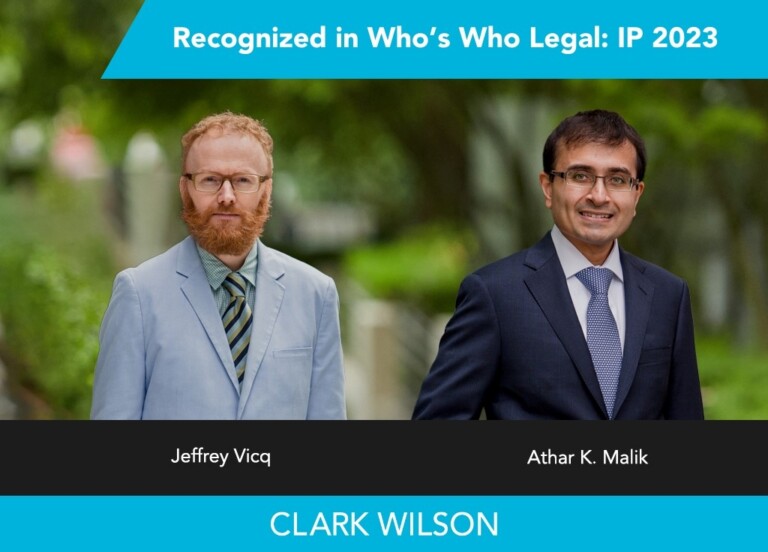Trademarks represent one of the most important assets of many businesses, serving to distinguish their products and services from those of their competitors. Given the potential value of trademarks to almost any business and the cost of building brand awareness in the marketplace, the selection of an enforceable trademark is crucial.
What is a Trademark?
A trademark is almost anything that is used to identify product or service and to distinguish it from the products or services of others. A trademark can be a word or words, a name, a shape, a logo, a slogan, a colour applied to a product, a representation of a label, a series of musical notes, or a combination of any of these. It can also be an Internet domain name, but not all domain names are trademarks.
A trademark can be contrasted with other forms of intellectual property protection such as patents (which protect inventions that are new and useful devices, processes or compositions of matter), copyright (which protects the expression of literary, artistic, musical and dramatic works, such as books, recordings, computer software, paintings and films), industrial designs (which protect the non-functional ornamentation of products such as the shape of a bottle or toaster) and trade-secrets (which protect confidential and valuable information).
Selecting an Enforceable Trademark
What is meant by the word “enforceable”? Basically, it means the ability of the owner of a mark to stop others from using similar trademarks in association with similar products and services. A trademark is likely to be more enforceable if it is “distinctive”, i.e. it actually serves to distinguish the goods or services of the owner of that mark from those of others. Distinctive marks are generally given a wider scope of protection by the courts in trademark proceedings.
In terms of distinctiveness and enforceability, there are essentially four types of trademarks, namely fanciful, arbitrary, suggestive and descriptive or generic marks.
Fanciful trademarks are words or phrases that have no meaning at all and that do not suggest the products or services that they are used in association with. For example, the trademarks EXXON, XEROX, and IZOD have no meaning at all. Fanciful trademarks are the most enforceable as they are the most distinctive and are therefore accorded a wider scope of protection than arbitrary, suggestive and descriptive marks.
Arbitrary trademarks are words that have a meaning, but not a meaning that describes the relevant goods or services. For example, the marks STARBUCKS, THE GAP and LOTUS do not describe or suggest coffee, clothing or computer software, respectively.
Suggestive trademarks suggest a quality or characteristic but do not describe the products or services that they are used in association with. Examples include EVEREADY for batteries, WHIRLPOOL for appliances and MICROSOFT for computer software. After fanciful and arbitrary marks, suggestive marks are the next most desirable from a trademark enforceability point of view.
Descriptive or generic trademarks are usually the hardest marks to enforce. Such marks describe a quality or characteristic of the products or services that they are used in association with. It is a well-established principle of trademark law that no-one should be able to expropriate for their own exclusive use a word or words that describe the product or service that they are used with. Examples of descriptive or generic marks include GOLDEN for beer and SHREDDED WHEAT for biscuits.
Notwithstanding the above, descriptive or generic trademarks can, through long and extensive use, acquire distinctiveness so as to become enforceable. Conversely, fanciful or arbitrary words or phrases can become so well used and misused in common parlance that they themselves become generic or descriptive and therefore unprotectable (for example, WINDSURFER for sailboards, ASPIRIN for painkillers and REFRIGERATOR for cold storage devices).
There is often an inherent tension between the technicalities of trademark law and the demands of the marketplace and the marketing department. Suggestive and descriptive marks tend to be favoured by marketing departments as they are intuitively easier to sell to the intended consumer of the product or service in question. The use of a fanciful or arbitrary mark creates an immediate hurdle, as the intended consumer must first be educated as to what is being sold in association with that mark. Assuming a trademark owner is willing and able to assist the consumer in overcoming that initial hurdle however, the owner’s ability to more easily enforce and protect that mark should normally override the initial “costs”.
Internet domain names may be enforceable as trademarks if they are used in a trademark sense; i.e. they are used in association with goods and/or services that a third party gives some consideration for. If a domain name is used only as an address or locater of a web site (which is what they were originally intended to be), it likely is not being used in a trademark sense. If the domain name (and web site) is used to simply provide promotional information about the goods or services of the owner, then it is likely not being used in a trademark sense. To add to the confusion, it is quite common for a domain name to include a trademark, usually as part or all of the second level domain. At the end of the day, it all comes down to how the domain name is actually being used, which is always fact specific.
Other Problems to Avoid
There are a number of other pitfalls which should be avoided when selecting a trademark. For example, a trademark will not be enforceable, and may be infringing, if it is confusing with a trademark or business name that is already in use with similar products or services. The best way to identify such problems is to first carry out proper searches. With the advent of the Internet and doing business on-line, the geographic scope of any searches must be carefully considered.
If a mark is famous in Canada, it may be entitled to a scope of protection that is wider than normally would be accorded to other less famous trademarks. For example, even though McDONALD’ S is used for primarily fast-food-related products and services, uses of this mark by others for even unrelated products or services might not be permissible.
Trademarks that are the surname of an individual are usually a poor first choice, as are trademarks that are well known geographic place names or that are translations of descriptive words in languages other than French or English.
Trademarks that are mere puffery (also known as “laudatory epithets”), such as BEST, FINEST, PREFERRED or TOP QUALITY are considered descriptive and should be avoided. Words or symbols that are commonly used in an industry by others, such as ECOMMERCE and OPEN SOURCE, are also poor trademarks, as are marks comprised only of letters, numbers or acronyms.
While marks which break the above rules may become distinctive enough to become enforceable, the scope of protection available to such marks will generally be narrow. This means other parties will likely to able to use similar marks with similar products or services.
Registrability
As well as determining the scope of protection available to a trademark, the above rules also apply to registrability of trademarks under the Canadian Trademarks Act and the Trademarks statutes of many other countries in the world. Registration under the Canadian Trademarks Act gives the registered owner extensive rights that an owner of an unregistered mark does not have, namely the exclusive right to use the registered trademark throughout Canada in association with the products and services set out in the registration. This right applies even though the owner may only actually be using the mark in one small geographic area of Canada. Trademark registration is also required in order to bring infringement proceedings under the Trademarks Act. Generally speaking, any trademark that is registrable should be registered in order to best protect the owner’s rights.
There are significant differences between registering a trademark under the Federal Trademarks Act and simply incorporating a company under one of the Provincial or Federal incorporation statutes and/or applying to register a trade name under one of the Provincial trade name registration statutes. Incorporation and trade name registration do not provide nearly the same level of protection as a Federal trademark registration. They are merely evidence that such corporate names or trade names were found “allowable” by the Provincial and Federal authorities charged with administering those registries – normally a very low threshold – and confer no rights to actually use those names in carrying on business or to sue other parties for infringement of trademark rights.
Proper Trademark Usage
Unless a trademark is used properly, the most distinctive trademark in the world can become unenforceable. Trademarks should be used as proper adjectives and not as nouns or verbs in order to avoid becoming generic or descriptive terms for the relevant product or service and thereby unenforceable. Trademarks should be used as adjectives followed by a generic term, for example: “Please pass me a KLEENEX tissue”, or “Please make me a XEROX photocopy”. Trademarks should not be pluralized as they are not nouns. Trademarks should also not be used in their possessive form unless the mark itself is possessive.
Trademarks that are registered should always be used in the exact form registered. Even minor changes to a registered mark can lead to difficulty in enforcing trademark rights. The use of proprietary notices is also recommended. The symbol TM should be used for marks that are in use but not registered. The symbol ® should be used in Canada with trademarks that are registered in Canada. The following legend should also be used wherever possible with trademarks:
“______________ is a (registered) trademark of ______________.”
If someone other than the owner is using the trademark with the authority of the owner, that use should be documented in a written Licence Agreement and a proprietary notice should be used which indicates that there is a licence in place, such as:
“_______________ is a (registered) trademark of __________________ and used under licence by ________________.”
As the value of trademarks as business assets continues to grow, so will the need to carefully select, protect and maintain those trademarks. This article provides only a very brief summary of some guiding principles in this regard. It is important to consider these principles carefully before committing to large sums on marketing activities. The day before a trade show or a new product launch is far too late. A lawyer or trademark agent experienced in this area should be considered as an extension of your marketing department and should be involved early on in the selection process in order to avoid expensive problems down the road.
For assistance, please contact a member of our Intellectual Property Group.


